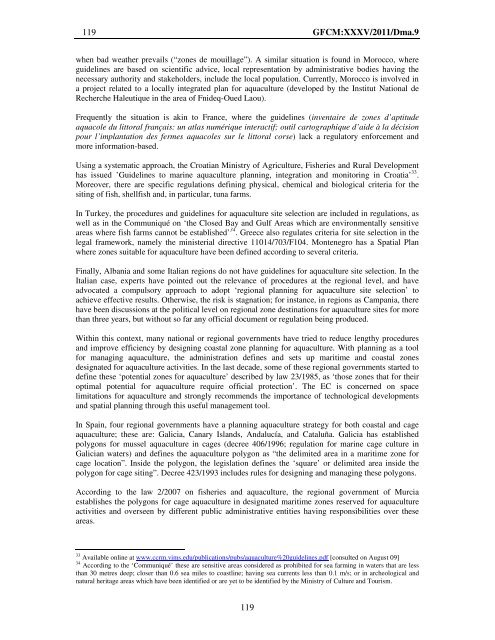Site selection and carrying capacity in Mediterranean ... - FAO Sipam
Site selection and carrying capacity in Mediterranean ... - FAO Sipam
Site selection and carrying capacity in Mediterranean ... - FAO Sipam
Create successful ePaper yourself
Turn your PDF publications into a flip-book with our unique Google optimized e-Paper software.
119 GFCM:XXXV/2011/Dma.9<br />
when bad weather prevails (“zones de mouillage”). A similar situation is found <strong>in</strong> Morocco, where<br />
guidel<strong>in</strong>es are based on scientific advice, local representation by adm<strong>in</strong>istrative bodies hav<strong>in</strong>g the<br />
necessary authority <strong>and</strong> stakeholders, <strong>in</strong>clude the local population. Currently, Morocco is <strong>in</strong>volved <strong>in</strong><br />
a project related to a locally <strong>in</strong>tegrated plan for aquaculture (developed by the Institut National de<br />
Recherche Haleutique <strong>in</strong> the area of Fnideq-Oued Laou).<br />
Frequently the situation is ak<strong>in</strong> to France, where the guidel<strong>in</strong>es (<strong>in</strong>ventaire de zones d’aptitude<br />
aquacole du littoral français: un atlas numérique <strong>in</strong>teractif; outil cartographique d’aide à la décision<br />
pour l’implantation des fermes aquacoles sur le littoral corse) lack a regulatory enforcement <strong>and</strong><br />
more <strong>in</strong>formation-based.<br />
Us<strong>in</strong>g a systematic approach, the Croatian M<strong>in</strong>istry of Agriculture, Fisheries <strong>and</strong> Rural Development<br />
has issued ’Guidel<strong>in</strong>es to mar<strong>in</strong>e aquaculture plann<strong>in</strong>g, <strong>in</strong>tegration <strong>and</strong> monitor<strong>in</strong>g <strong>in</strong> Croatia’ 33 .<br />
Moreover, there are specific regulations def<strong>in</strong><strong>in</strong>g physical, chemical <strong>and</strong> biological criteria for the<br />
sit<strong>in</strong>g of fish, shellfish <strong>and</strong>, <strong>in</strong> particular, tuna farms.<br />
In Turkey, the procedures <strong>and</strong> guidel<strong>in</strong>es for aquaculture site <strong>selection</strong> are <strong>in</strong>cluded <strong>in</strong> regulations, as<br />
well as <strong>in</strong> the Communiqué on ‘the Closed Bay <strong>and</strong> Gulf Areas which are environmentally sensitive<br />
areas where fish farms cannot be established’ 34 . Greece also regulates criteria for site <strong>selection</strong> <strong>in</strong> the<br />
legal framework, namely the m<strong>in</strong>isterial directive 11014/703/F104. Montenegro has a Spatial Plan<br />
where zones suitable for aquaculture have been def<strong>in</strong>ed accord<strong>in</strong>g to several criteria.<br />
F<strong>in</strong>ally, Albania <strong>and</strong> some Italian regions do not have guidel<strong>in</strong>es for aquaculture site <strong>selection</strong>. In the<br />
Italian case, experts have po<strong>in</strong>ted out the relevance of procedures at the regional level, <strong>and</strong> have<br />
advocated a compulsory approach to adopt ‘regional plann<strong>in</strong>g for aquaculture site <strong>selection</strong>’ to<br />
achieve effective results. Otherwise, the risk is stagnation; for <strong>in</strong>stance, <strong>in</strong> regions as Campania, there<br />
have been discussions at the political level on regional zone dest<strong>in</strong>ations for aquaculture sites for more<br />
than three years, but without so far any official document or regulation be<strong>in</strong>g produced.<br />
With<strong>in</strong> this context, many national or regional governments have tried to reduce lengthy procedures<br />
<strong>and</strong> improve efficiency by design<strong>in</strong>g coastal zone plann<strong>in</strong>g for aquaculture. With plann<strong>in</strong>g as a tool<br />
for manag<strong>in</strong>g aquaculture, the adm<strong>in</strong>istration def<strong>in</strong>es <strong>and</strong> sets up maritime <strong>and</strong> coastal zones<br />
designated for aquaculture activities. In the last decade, some of these regional governments started to<br />
def<strong>in</strong>e these ‘potential zones for aquaculture’ described by law 23/1985, as ‘those zones that for their<br />
optimal potential for aquaculture require official protection’. The EC is concerned on space<br />
limitations for aquaculture <strong>and</strong> strongly recommends the importance of technological developments<br />
<strong>and</strong> spatial plann<strong>in</strong>g through this useful management tool.<br />
In Spa<strong>in</strong>, four regional governments have a plann<strong>in</strong>g aquaculture strategy for both coastal <strong>and</strong> cage<br />
aquaculture; these are: Galicia, Canary Isl<strong>and</strong>s, Andalucía, <strong>and</strong> Cataluña. Galicia has established<br />
polygons for mussel aquaculture <strong>in</strong> cages (decree 406/1996; regulation for mar<strong>in</strong>e cage culture <strong>in</strong><br />
Galician waters) <strong>and</strong> def<strong>in</strong>es the aquaculture polygon as “the delimited area <strong>in</strong> a maritime zone for<br />
cage location”. Inside the polygon, the legislation def<strong>in</strong>es the ‘square’ or delimited area <strong>in</strong>side the<br />
polygon for cage sit<strong>in</strong>g”. Decree 423/1993 <strong>in</strong>cludes rules for design<strong>in</strong>g <strong>and</strong> manag<strong>in</strong>g these polygons.<br />
Accord<strong>in</strong>g to the law 2/2007 on fisheries <strong>and</strong> aquaculture, the regional government of Murcia<br />
establishes the polygons for cage aquaculture <strong>in</strong> designated maritime zones reserved for aquaculture<br />
activities <strong>and</strong> overseen by different public adm<strong>in</strong>istrative entities hav<strong>in</strong>g responsibilities over these<br />
areas.<br />
33 Available onl<strong>in</strong>e at www.ccrm.vims.edu/publications/pubs/aquaculture%20guidel<strong>in</strong>es.pdf [consulted on August 09]<br />
34 Accord<strong>in</strong>g to the ‘Communiqué’ these are sensitive areas considered as prohibited for sea farm<strong>in</strong>g <strong>in</strong> waters that are less<br />
than 30 metres deep; closer than 0.6 sea miles to coastl<strong>in</strong>e; hav<strong>in</strong>g sea currents less than 0.1 m/s; or <strong>in</strong> archeological <strong>and</strong><br />
natural heritage areas which have been identified or are yet to be identified by the M<strong>in</strong>istry of Culture <strong>and</strong> Tourism.<br />
119
















